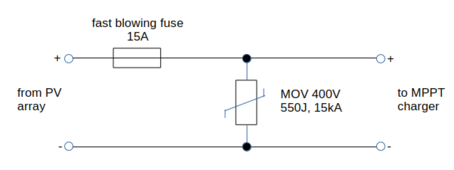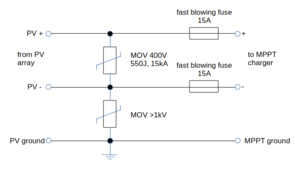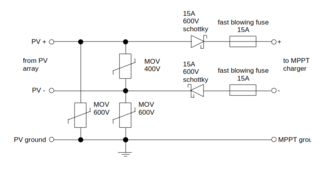fmeili1
Solar Enthusiast
Hi,
I'm using 8 PV strings connected to 8 individual MPPT chargers and I think about to protect the MPPT's against surges with SPD's. I'm pretty sure, it would not help against a direct lightning hit, but maybe against a lightning strike near by (all strings are correctly earthed).
Because I need 8 of them it would cost about $800 bugs (e.g. Midnight solar SPD), I think about building them by myself.
The max. MPPT input voltage is 500VDC but my max. string voltage Voc will not be over 350VDC (even with the lowest temperatures). The max. string Isc will be 14A (but usual with MPPT working <10A).
I think about the following circuit to place before each MPPT entry (inside the metal cable channel located underneath the AIO inverter/chargers):

I think about placing each circuit in a separate 3D printed case to prevent hot particles flying around in case the MOV will explode in case of an surge event. I also hope that the fast blowing fuse will blow fast enough to not produce too much heat energy in the MOV in case of such an event. The case may be melt a bit in such an event but that would be ok if the heat energy will stop with the blowing fuse soon enough. I'm also not sure if the 550J MOV energy will be ok for what I want to achieve.
Also I'm not sure if such SPD's may also be useful between PV+ and ground and PV- and ground to even better protect the MPPT's (it's a non-isolated AIO)?
I ask myself if this simple circuit (cost <$10 for each unit with clamps and cases) would really help to protect anything?
Any comments welcome!
I'm using 8 PV strings connected to 8 individual MPPT chargers and I think about to protect the MPPT's against surges with SPD's. I'm pretty sure, it would not help against a direct lightning hit, but maybe against a lightning strike near by (all strings are correctly earthed).
Because I need 8 of them it would cost about $800 bugs (e.g. Midnight solar SPD), I think about building them by myself.
The max. MPPT input voltage is 500VDC but my max. string voltage Voc will not be over 350VDC (even with the lowest temperatures). The max. string Isc will be 14A (but usual with MPPT working <10A).
I think about the following circuit to place before each MPPT entry (inside the metal cable channel located underneath the AIO inverter/chargers):

I think about placing each circuit in a separate 3D printed case to prevent hot particles flying around in case the MOV will explode in case of an surge event. I also hope that the fast blowing fuse will blow fast enough to not produce too much heat energy in the MOV in case of such an event. The case may be melt a bit in such an event but that would be ok if the heat energy will stop with the blowing fuse soon enough. I'm also not sure if the 550J MOV energy will be ok for what I want to achieve.
Also I'm not sure if such SPD's may also be useful between PV+ and ground and PV- and ground to even better protect the MPPT's (it's a non-isolated AIO)?
I ask myself if this simple circuit (cost <$10 for each unit with clamps and cases) would really help to protect anything?
Any comments welcome!
Last edited:






